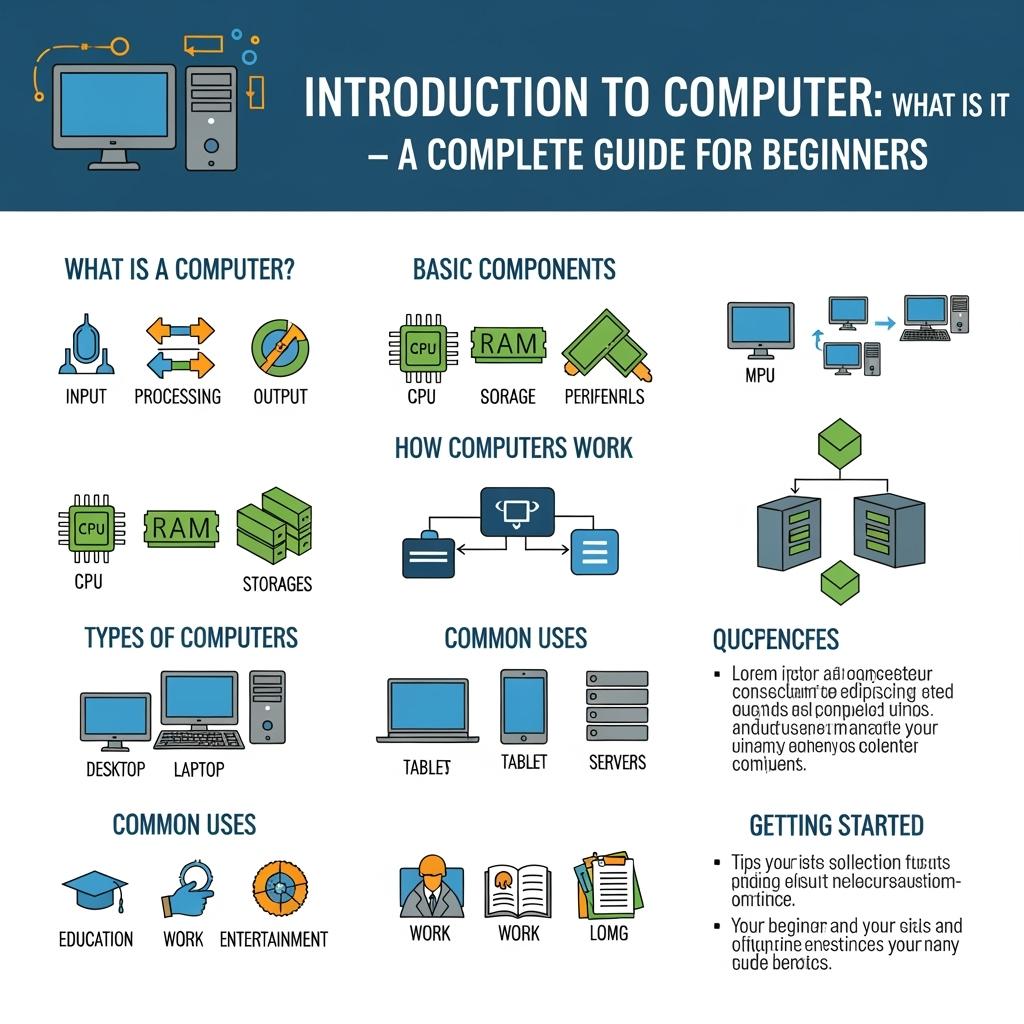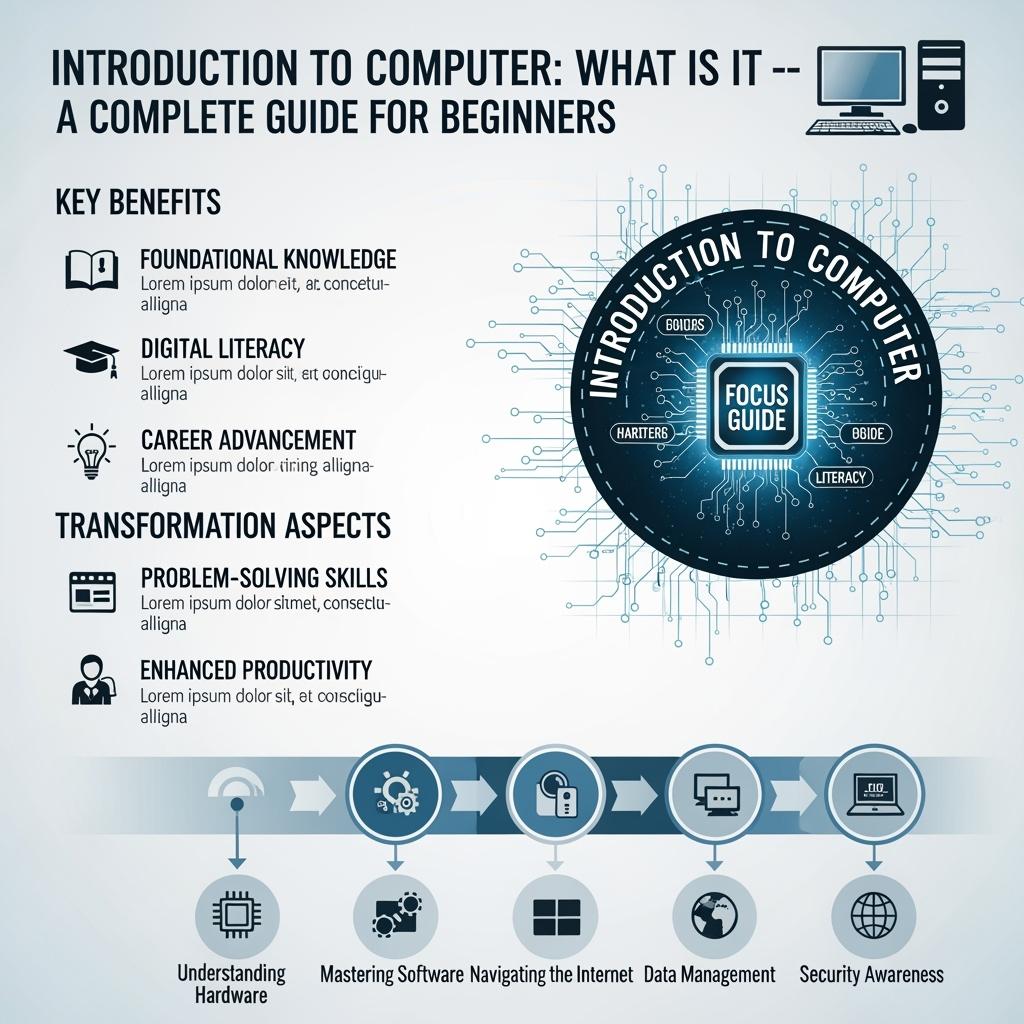Introduction
This introduction to computers, What Is It? A Complete Guide for Beginners, will help you understand everything you need to know about computers. Whether you browse the internet, work from home, or simply use a smartphone, computers play a vital role in your daily life. Many people in the UK and USA rely on computers for work, entertainment, and staying connected with family and friends. Understanding the basics becomes essential when you consider that over 95% of households in both countries own at least one computing device.
This introduction to computers, the What Is It? a complete guide for beginners article, breaks down complex concepts into simple terms that anyone can understand. From desktop computers to smartphones, these electronic devices process information and help us complete tasks more efficiently. By the end of this introduction to computers, What Is It? a complete guide for beginners, you will have a clear understanding of what computers are, how they work, and why they matter in today’s digital age.
What is a computer?
A computer is an electronic apparatus created to process, store, and retrieve data swiftly and effectively. It performs a wide range of tasks—from basic calculations to complex operations—by following instructions called programs or software. Modern computers come in various forms, including desktops, laptops, tablets, and smartphones, and are used in nearly every aspect of daily life, from education and business to entertainment and communication.
Types of Computers
Desktop Computers
Desktop computers remain popular choices for offices and homes across the UK and USA. These stationary devices offer powerful processing capabilities and large screens that make them ideal for work tasks, gaming, and creative projects. Desktop computers typically cost less than laptops with similar specifications, making them budget-friendly options for families.
Laptop Computers
Laptops provide portability without sacrificing functionality. These portable computers have all the parts of desktop computers but in a small, foldable design. Battery power allows users to work from anywhere, making laptops essential tools for students, professionals, and travelers. Current statistics show that laptops account for over 60% of computer purchases in both the UK and USA.
Tablets
Tablets bridge the gap between smartphones and laptops. These touch-screen devices offer convenience for reading, browsing the internet, and consuming media content. Many people use tablets for entertainment, online shopping, and staying connected on social media platforms.
Smartphones
Smartphones represent the most common type of computer that people carry daily. These pocket-sized devices perform many functions of traditional computers while providing communication capabilities. Nearly everyone in the UK and USA owns a smartphone, making them the most widespread computing devices in both countries.
Main Components of a Computer
Central Processing Unit (CPU)
The CPU acts as the brain of all computers. This component executes instructions and performs calculations that make programs run smoothly. Modern CPUs contain multiple cores that allow computers to handle several tasks simultaneously, improving overall performance and efficiency.
Memory (RAM)
Random Access Memory holds temporary information that the CPU requires for quick access. Having more RAM enables computers to operate several programs seamlessly without lagging. You can think of RAM as the computer’s short-term memory, which aids in effective multitasking.
Storage
Storage devices hold onto your files, applications, and operating system for the long term. Traditional hard drives use spinning disks to store data, while solid-state drives use electronic memory for faster access. Cloud storage services also provide remote storage options that many UK and USA users prefer for backing up important files.
Motherboard
The motherboard connects all computer components together, allowing them to communicate with each other. This main circuit board houses the CPU, RAM, and other essential parts while providing connections for external devices like keyboards, mice, and monitors.
Power Supply
Power supplies convert electricity from wall outlets into the specific voltages that computer components need to operate. Reliable power supplies ensure stable performance and protect sensitive electronics from power fluctuations.
Common Uses of Computers
Work and Productivity
Computers transform how people work in the UK and USA. Remote work capabilities allow employees to collaborate with colleagues across different locations. Document creation, spreadsheet management, and presentation design have become standard computer applications in most industries.
Communication
Email, video calls, and messaging applications connect people worldwide. Social media platforms help individuals maintain relationships and share experiences with friends and family. . These communication tools have become essential for both personal and professional interactions.
Entertainment
Streaming services, gaming platforms, and digital media consumption rely heavily on computer technology. A lot of families use computers to stream movies, enjoy music, and play video games. The entertainment sector keeps changing as computer technology improves.
Education
Online learning platforms and educational software provide flexible options for studying. Students access courses, complete assignments, and participate in virtual classrooms using computers. Educational technology has revolutionized how people acquire new skills and knowledge.
Benefits of Using Computers
Efficiency and Speed
Computers complete tasks much faster than manual methods. Calculations that might take hours by hand can be completed in seconds using computer software. This increase in efficiency helps individuals get more done in a shorter amount of time.
Information Access
The internet gives us fast access to a huge amount of information. Research that used to need trips to the library can now be done from home with search engines and online databases.
Automation
Computers can perform repetitive tasks automatically, reducing human error and freeing up time for more important activities. Automated systems handle everything from bill payments to inventory management in businesses.
Global Connectivity
Computers enable worldwide communication and collaboration. People can work with colleagues on different continents, maintain relationships across long distances, and access services from anywhere with internet connectivity.
Conclusion
Computers have become essential in modern life, evolving from simple tools into powerful devices that enhance productivity, communication, and daily tasks. This introduction highlights their key components, practical uses, and growing importance across all age groups and professions. As technology advances, computers will remain central to how we work, learn, and connect.
Frequently Asked Questions
What is the difference between hardware and software?
Hardware refers to physical computer components you can touch, while software includes programs and applications that run on the hardware.
How much RAM do I need for basic computer use?
Most users find 8GB of RAM sufficient for web browsing, email, and basic productivity tasks, though 16GB provides better performance for multitasking.
Can I use a computer without an internet connection?
Yes, computers can run many applications offline, including word processors, games, and media players, though internet connectivity enhances functionality significantly.



